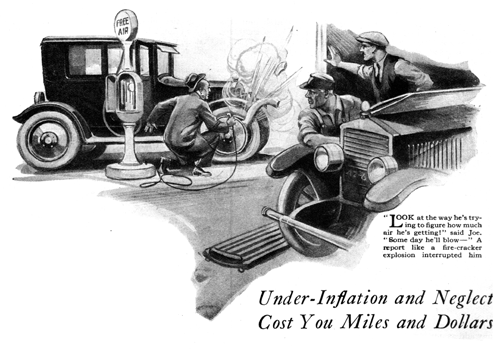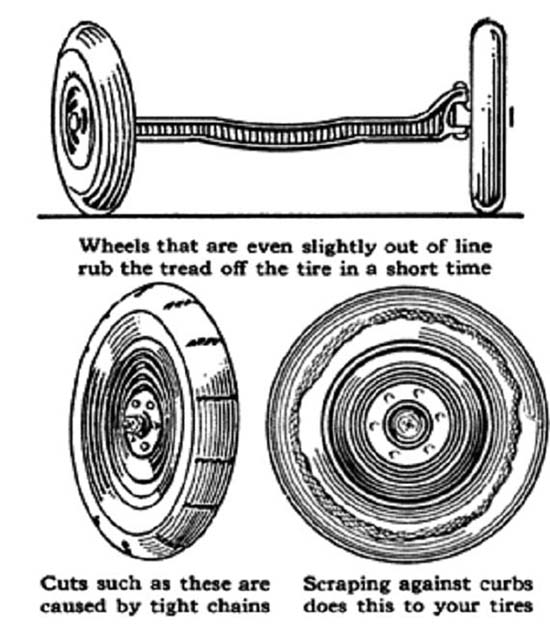June 1927
HOW TO SAVE MONEY ON TIRES
by Martin Bunn

Old Burr sure has a permanent cramp in his pocket-book," grinned Joe Clark to his partner, Gus Wilson, as their departing customer let in the clutch and drove away from the Model Garage.
"He's penny-wise and pound-foolish," observed Gus. "Our prices on tires are reasonable and we don't palm off stale stock. Just wait till he gets stuck good and plenty on a 'gyp' tire, then we'll have him for a regular customer!"
About a week later, Burr pulled up in front of the Model Garage near the air pump and proceeded to apply the hose in his tires. There was a new shoe on his right front wheel, Gus noted.
"I've tried to sell him a tire pressure gage," said Joe. "The old tightwad won't buy one. Just look at the way he's trying to figure how much air he's getting! Kicking the tires won't tell him anything. Someday he'll blow. -- "
A report like a fire-cracker explosion interrupted him. Burr in an instant was enveloped in a cloud of dusty tire talc.
"By Jinks, he's gone and done it!"
The two men rushed over to Burr, who was vainly trying to dig the dust out of his eyes. Apparently the tire had torn loose from the rim and the blow-out had ripped a five-inch piece out of the tube. Both the new shoe and the tube were completely ruined.
"I'll have the law on 'em for selling me a dangerous article," blustered Burr when he had recovered from his amazement. "They guaranteed that tire, and I'll see that they make good!"
"If you do," soothed Gus, "it will be the first time I ever heard of a gyp making good on anything. Besides, you can't prove you didn't blow it up too hard, working without a gage."
"But I can tell by kicking when they're getting enough air," protested the angry motorist. "I never had any trouble like this before."
"Your toe must be a lot more sensitive than mine, then," growled Gus. He bent over to inspect the wrecked shoe. "This sure is a gyp 'baloney' for fair. Hardly any wires in the bead -- no wonder it stretched over the edge of the rim. And look how thin the rubber is."
"Humph!" snapped Burr, "And how do you account for the fact that I got fine mileage out of the last shoe I bought from that same dealer?"
"Good luck that's all," Gus answered.
"You might have as good luck again if you buy more of his junk tires. But you can take it from me, when a man sells you a tire at half the regular price, it isn't worth even that.
"The worst of it is that it takes an expert to tell what's the matter with a cheap tire. It may look all right, but how do you know that it isn't over-cured? Or maybe there's a break in the cord fabric under the rubber.
"It's all right to talk about 'factory blemished' tires and how there's nothing the matter with them except possibly an 'irregularity in the tread' or that they 'don't look just right,' but you can bet your boots the factory inspectors aren't going to throw out a tire just because there's a couple of fly specks on it. The inspectors are paid for knowing how to find real defects that will shorten the life of the tire, and when they say it's not up to snuff you can take it they're right.
"Of course this tire wasn't even a good factory 'second.' It's just a junk tire made to sell at any price and still give the dealer a big profit."
"Perhaps you're right," admitted Burr, half convinced in spite of himself.
"How much did you say you'd charge me for a new shoe with a bit of discount for cash?"
"I'll throw in a really good tire gage as discount," grinned Joe. "It'll save you more dollars than any cash discount."
"I'll take it," agreed Burr. "It seems like a lot of money to be spending on one tire, though."
"Not when you figure it out on a dollars per mile basis. That's all you're getting out of any tire -- so many miles of running at so many cents a mile, and if you can get twice as many miles out of a tire that costs only a quarter or a third more, you're making a big saving. If some manufacturer could make tires that would give fifty thousand miles instead of the ten or fifteen you get now, they'd certainly be bargains at a hundred dollars apiece."
"There are other ways you can save money on tires, too." Gus added as he started mounting the new shoe on the rim. "Taking care of them is the best way I know of. First and most important, keep 'em pumped up to the right pressure all the time. Joe'll give you a chart that shows the right pressure. Keep the pressure two or three pounds more than the low limit shown in the table. Also, you want to remember that the weight the tires carry is what determines the amount of air you want in 'em. If you get on a long trip alone, you can get easiest riding qualities, by having the air pressure shown pretty near the low limit.
"On the other hand, if you start out with four or five big, husky chaps in the car besides yourself, and a lot of luggage for good measure, remember to pump the tires hard enough to take care of the extra weight. Three heavy men on the back seat and a trunk strapped on behind may add as much as three hundred pounds apiece to the load on each rear tire, and if the pressure is down to the minimum figured for the weight of the car alone, the extra weight will squash out the tires and the side walls will get too much bending. That means destructive friction in the cord fabric in the side walls of the tire, and if you happen to run over a car track or a brick, you are almost sure to get what is known as a rim bruise. The tire may look all right for quite a while afterward, and then there'll be a mysterious blow out."
"That explains what must have happened to a shoe that blew out last year." said Burr. "It looked like a defect to me, but now that I think of it, there was a slight dent in the rim at that point."
"Sometimes you can dent a rim without damaging the tire," explained Gus, "but a dent in a rim is a bad sign. If you have tried to pound a dent out of a rim, you know how tough the steel is. It takes a thumping hard blow to put a dent in one. That blow is transmitted to the rim through the walls of the tire."
"Then if I keep my tires pumped to the right pressure, my troubles will be over?" questioned Burr.
"Most of them will be, but other little things can cause a lot of grief. A piece of glass in the road may make a cut in the rubber tread that looks too trifling to bother with. Water gets into the cord fabric through the hole and rots the cords. After a while the tire blows out at that point; or maybe sand works under the tread, raises a blister and eventually ruins a part of the tread.
"Watch out that your tire chains aren't too tight too. If you don't have them loose enough so that they can creep around the tire, they will cut right into the rubber."
"I don't use chains much anyway," said Burr, "so that doesn't bother me, but what am I supposed to do about those little cuts and things?"
"The safest way is to go over your tires once a week." Gus advised. "If you find small cuts in the tread, fill up the hole with tire dough; if a piece of the tread has been torn away, have it vulcanized before it gets any worse.
"How many miles have you driven this other front tire?" Gus inquired, bending over to inspect the tread.
"What's the matter with it?" countered Burr suspiciously. "It's nearly new. I put it on about a month ago."
"I can tell that by looking at it," Gus laughed, "but I have a hunch that the wheels are out of line. The tread seems to have a rubbed appearance caused by the sidewise slip that always happens when the wheels aren't in line. Have you bumped into anything lately?"
"Certainly not," replied Burr.
"That is, I haven't hit anything. About two weeks ago, though I got into a jam and had to drive up over a high curbstone to save smashing into a car. It jarred the car quite a bit."
"That's what's the matter, then," said Gus. "You must have hit the curb at an angle and the sudden strain bent one of the steering knuckles a trifle. I'll line up the wheels for you right away. You want to watch out that the front wheels don't get any sidewise bumps like that. Even running the front wheel against the curb when you're parking the car will sometimes spoil the alignment. Driving fast in deep ruts is bad, too. Wheels that are out of line as much as a quarter or a half inch will grind off the tread in no time."
"I should think that if the front wheels were out of alignment you would notice it in the steering," observed Burr.
"Not necessarily," Gus replied. "A slight error throws both wheels out a trifle, and the strain is divided between them. Besides that, the steering wheels on modern cars are geared so low to make easy steering with balloon tires that a slight drag would hardly be noticed. The only safe way is to have them checked up occasionally, especially when the front shoes seem to be wearing more than they ought to.
"Here's another point that lots of drivers don't realize. Extra wear is put on the tires if one of the wheels wobbles because the axle is bent or because the rim isn't on straight. This accounts for many queer cases where the tread seems to wear away much more at two points on opposite sides of the tire, remaining unworn at the sections between. You see, each time the wheel turns, a part of the tire moves sidewise as well as straight ahead, and that means extra friction."
"Well!" said Burr. "My neighbor's tires never seem to wear out, and now I think I know why! I notice he's always testing the pressure or looking them over. I thought that was all foolishness and a waste of time, but there may be something in it after all."
"Two things," Gus stated. "First, you save money because your tires actually give you more miles. Second, if you know just how you stand on the tire question, you're not likely to get stuck with a flat tire so often."
END
L. Osbone 2019

